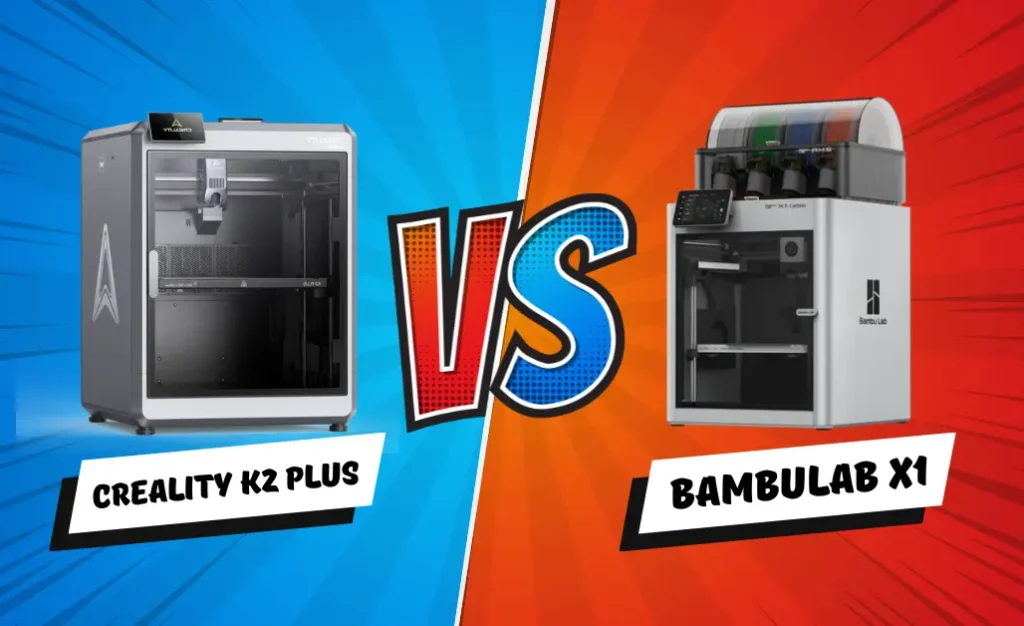3D printing has revolutionized manufacturing, prototyping, and creative projects, making it a go-to solution for professionals and hobbyists alike. Among the numerous brands in the market, Bambulab and Creality stand out for their innovation and reliability. In this article, we will compare two of their popular models: the Bambulab X1 and Creality K2 Plus. This detailed comparison will help you decide which printer aligns better with your needs, whether you’re a beginner or an advanced user.

Key Features Comparison
1. Print Quality
- Bambulab X1: Renowned for its exceptional print resolution and precision, the X1 offers a layer height as small as 0.05mm, ensuring intricate details and smooth surfaces.
- Creality K2 Plus: While it delivers impressive print quality, its resolution slightly lags behind the X1, with a minimum layer height of 0.1mm.
2. Build Volume
- Bambulab X1: Features a build volume of 256 x 256 x 256 mm, suitable for most projects, including medium-sized prototypes and models.
- Creality K2 Plus: Provides a larger build volume of 300 x 300 x 350 mm, making it ideal for bigger projects and prints that require more space.
3. Print Speed
- Bambulab X1: Supports a maximum print speed of 500 mm/s, ensuring quicker turnarounds without sacrificing quality.
- Creality K2 Plus: Operates at a maximum speed of 400 mm/s, which is slightly slower but sufficient for most applications.
4. Material Compatibility
- Bambulab X1: Compatible with a wide range of materials, including PLA, ABS, PETG, TPU, and some specialty filaments.
- Creality K2 Plus: Offers similar compatibility but has slightly fewer preset profiles for specialty materials.
5. Ease of Use
- Bambulab X1: Features an intuitive touchscreen interface, auto-bed leveling, and built-in filament detection, making it user-friendly for beginners.
- Creality K2 Plus: Includes auto-bed leveling and filament runout detection but has a slightly less refined UI compared to the X1.
Price Point
- Bambulab X1: Positioned as a premium option, the X1 is priced higher, catering to users who prioritize top-notch quality and advanced features.
- Creality K2 Plus: Offers a more budget-friendly alternative, making it an excellent choice for those who need a balance between cost and performance.
Pros and Cons
Bambulab X1
Pros:
- Exceptional print quality and precision
- High-speed performance
- Advanced features like AI-assisted monitoring
Cons:
- Smaller build volume
- Higher price point
Creality K2 Plus
Pros:
- Larger build volume
- Affordable pricing
- Robust material compatibility
Cons:
- Slower print speed
- Less polished interface
Ideal Use Cases
- Bambulab X1: Perfect for professionals needing intricate designs, small to medium-sized prototypes, and rapid production.
- Creality K2 Plus: Better suited for hobbyists, educators, and those working on larger projects.
FAQs
1. Which printer is better for beginners Bambulab X1 or Creality K2 Plus?
Both models are beginner-friendly, but the Bambulab X1’s intuitive interface and automated features make it slightly easier to operate.
2. Can both Bambulab X1 and Creality K2 Plus handle flexible materials?
Yes, both the Bambulab X1 and Creality K2 Plus can print TPU, a popular flexible filament.
3. Which printer is faster?
The Bambulab X1 has a higher maximum print speed of 500 mm/s, making it the faster option.
4. Are replacement parts readily available?
Yes, both brands offer robust customer support and easily accessible replacement parts.
5. Which printer offers better value for money?
The Creality K2 Plus provides better value for users on a budget, while the Bambulab X1 delivers premium features for those willing to invest more.
Conclusion
The choice between the Bambulab X1 and Creality K2 Plus ultimately depends on your specific needs and budget. If you prioritize speed, precision, and cutting-edge features, the Bambulab X1 is an excellent choice. However, if you’re looking for a larger build volume and a more affordable option, the Creality K2 Plus stands out. Both printers exemplify the innovation driving the 3D printing industry, ensuring high-quality results for various applications. By understanding their strengths and limitations, you can confidently select the printer that best suits your projects.